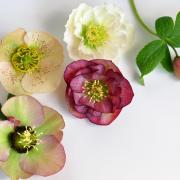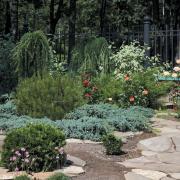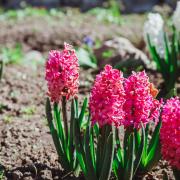Lavenders are one of my favourite plants for the garden, English lavenders in particular, can be planted from March to August and begin blooming from June through the summer. They are hardy and if they are planted in a sunny spot with well drained soil, they will last for a few years. Lavender is evergreen, so it can provide garden structure all year round.
For centuries, lavenders have been used for cosmetic, perfume and medicinal purposes. Often used in poultices for insect bites and swelling or as a sleep aid. In my previous life as an aromatherapist, I referred people to Lavandula angustifolia essential oil for its many different therapeutic properties. These include aiding in sleep, releasing stress or anxiety, calming the mind and body as well as for anti-inflammatory, anti-bacterial and pain-relieving purposes. A quick summer gardening tip: lavender oil mixed with a fragrance-free lotion makes a great soother on sunburnt skin, nettle stings and insect bites!
In the garden, lavenders are easy to grow and look good in almost any environment. There are so many to choose from, but we love these varieties for summer planting.
A lovely compact variety is Lavandula angustifolia ‘Hidcote,’ with dark violet flowers, interestingly, it is named after Hidcote Manor in Gloucestershire. A favourite amongst wildlife gardeners for its attraction to bees, butterflies and hoverflies, it can withstand really hot English summers making it fairly drought tolerant and look fantastic as edging for paths or in borders. They also make an excellent cut flower for fresh or dried arrangements. Hidcote is one of the most popular of the English varieties as it is not too fussy about the soil type in which it is planted, as long there is good drainage.
Lavandula angustifolia ‘Munstead’ is thought to be named after Gertrude Jekyll’s estate, Munstead Wood. This low growing variety produces dense spikes of lighter violet-blue summer flowers above slender, aromatic, grey-green leaves. This is a wonderful lavender for edging paths and borders. It also works well in a gravel garden or pruned into a formal shape for a more modern look. Great as a fragrant hedge and in a sensory garden, with its grey green foliage and various shades of purple flowers exuding a delightful aroma as you brush past.
Another favourite is Lavandula ‘Vera’ which is a small, evergreen lavender. Its stunning silvery grey leaves and violet blue flowers appear from July to September and make it an excellent choice for infilling parterres. With a deep fragrance, in the leaves and flowers, this variety is popular when making potpourri.
There is some maintenance involved in growing lavenders, to ensure repeat flowering, after the flowers have faded, give the plants a good trim, taking care not to cut into the older wood. If the Lavender becomes overgrown and straggly, prune it down by approximately a third every 2–3 years. In colder regions, where the plants may suffer from frost or wind damage, they should have a light trim in autumn, and then another trim in early spring.
Jobs in the July garden
• Prune Wisteria vines after flowering, cut back the whippy green shoots of this years growth to five or six leaves.
• Deadhead repeat flowering perennials such as Penstemon, Geraniums and Delphiniums to encourage more flowers.
• Feed and water sweet peas regularly and pick flowers every couple of days as pea pods reduce flowering potential.
• Feed hanging baskets regularly and pinch back straggly growth to keep plants in better shape.
• Check lilies regularly for bright red lily beetles – or their grubs which hide underneath the leaves covered in their own poo! Remove and destroy.
• Roses should be deadheaded regularly – spray with a fungicide if rust and black spot are prevalent.
Growing your own food:
• Catch veg while it's at its peak by harvesting regularly, don’t let it get bitter tasting.
• Harvest potatoes, carrots, beetroot, lettuce, tomatoes and salad leaves.
• Pinch outside shoots from vine tomatoes and feed with a high potash food like Tomorite. Make sure there is ventilation in the greenhouse and plants are well watered.
• Harvest garlic when the tops of the foliage turn yellow.
• Prune cherries and plums now, to avoid Silver Leaf disease.
• Sow small batches of salad leaves, rocket and radishes every few weeks for continuous pickings.



























